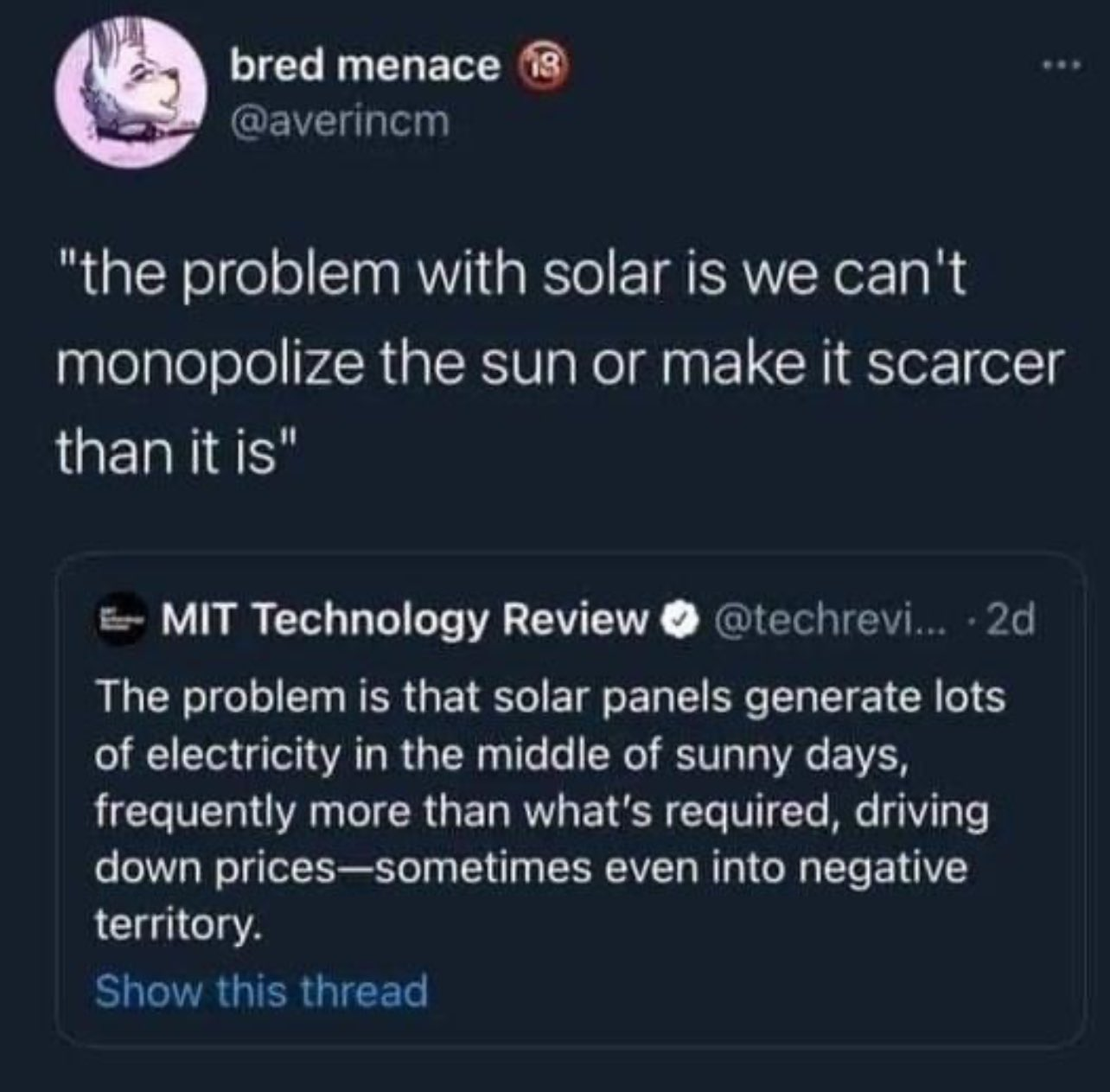this post was submitted on 02 Oct 2024
1689 points (95.6% liked)
Microblog Memes
5911 readers
4913 users here now
A place to share screenshots of Microblog posts, whether from Mastodon, tumblr, ~~Twitter~~ X, KBin, Threads or elsewhere.
Created as an evolution of White People Twitter and other tweet-capture subreddits.
Rules:
- Please put at least one word relevant to the post in the post title.
- Be nice.
- No advertising, brand promotion or guerilla marketing.
- Posters are encouraged to link to the toot or tweet etc in the description of posts.
Related communities:
founded 1 year ago
MODERATORS
you are viewing a single comment's thread
view the rest of the comments
view the rest of the comments

If you’re spending billions to build a solar plant that has to turn off all the time during peak hours then you’re wasting your money. That seems like a fundamental issue to me, not a non-issue.
Are there any solar plants that cost a billion dollars each?
Secondly, you want to over build solar, so that you have enough capacity during off peak hours. Grid storage is obviously the better solution, but seems not widely available enough yet.
It doesn’t matter how much solar you build; without storage you’ve got zero power available at night.
The issue with overbuilding solar is that you drive daytime electricity prices to zero so that everyone is losing money on all these solar plants. Furthermore, base load plants such as nuclear plants also start losing money and they have no ability to shut down during peak hours. So you end up driving the base load plants out of business and they shut down permanently. Now you have even less capacity available at night! This causes nighttime power to become extremely unreliable, potentially leading to rolling blackouts and skyrocketing nighttime energy prices.
Another issue that people rarely discuss is the quality of power on the grid. All the grids in the world operate on 50/60 Hz AC which must be carefully maintained at an accurate frequency and synchronized with the grid. The main base load turbines are the source of this waveform which is carefully monitored and adjusted to remain stable.
Solar panels produce DC power which needs to be converted into AC with an inverter and synchronized with the grid. The problem is that if all the base load turbines are taken off the grid then there is nothing for the solar inverters to synchronize with! Turbines are nice and stable because they’re literally an enormous, massive spinning flywheel. Without them you’ll have an extremely unstable system where all of the solar plants are trying to adjust their frequencies and phases to match each other and the whole thing wanders all over the place.
It's two sided.
Yes you waste money by not exporting the electricity-transformed version of your resource (wind, sun, chemical potential, etc.).
But on the flip side if you export lower across your whole site, this means more losses at the inverters which can shorten operational lifetimes and lead to quickened inverter failures and needs for replacement. Those maintenance costs eat into your profit as well.
As someone in the industry, I'd imagine that inverter-based producers really just react to the rate structures of whatever grid and utility they hook up to. If the incentives of that utility favor one mode of operation during supply-demand mismatches - such as complete site curtailment - then that is what generators will do. If the incentives favor partial generation where only certain blocks of your solar or wind or BESS plant are switched off while others remain on, then we could see more producers do that.
Ultimately though you need to have a way to operate your site in those conditions to help balance out operation and nonoperation. If whenever a curtailment signal comes to your site, and in response you always shut off Block B while leaving Block A on, then Block A will experience accelerated lifetime degradation over Block B. Inverters, transformers, cables, panels will fail faster in Block A than Block B. But if you could rotate your curtailment/demand response such that certain blocks/strings are used sequentially and that lifetimes are averaged out, this might solve the problem. Think about how farmers rotate which crops they plant in which of their fields to avoid famine and soil degradation.
I think demand response is taking off in the utilization markets like in buildings and industrial settings, but really I think the principles we've learned from that should be carried over to generation markets as well. It's only a matter of time as the industry matures and smart technology penetrates the grid and generation markets.